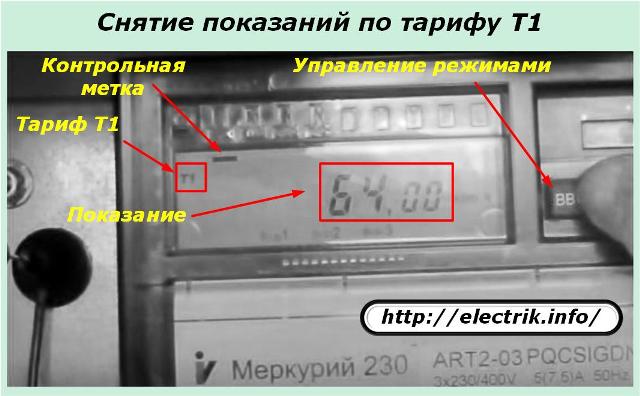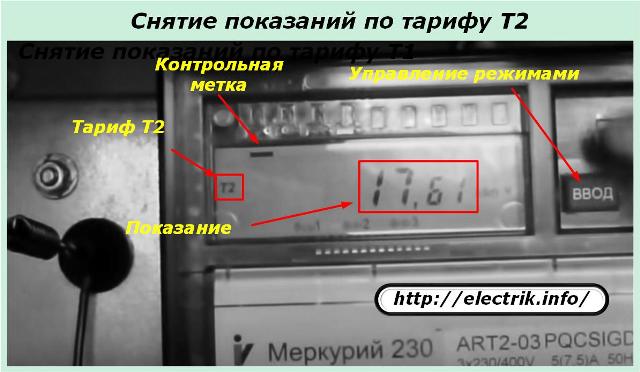Categories: Featured Articles » Electrician at home
Number of views: 153,378
Comments on the article: 2
How to take electricity meter readings
Since the 19th century, people have been using electricity, paying money for it. During this time, many methods of calculation between electricity supplying organizations and consumers have been tested, but, time has shown that the best option is to automatically record the work performed by the devices with their subsequent payment on the fact.
To this end, manufacturers of electrical equipment produce electric meterstaking into account the energy consumed by the consumer in different ways.
Nowadays, two of their types are common:
1. induction devices of old models, operating on the basis of an electromechanical design;
2. static products using electronic components and microprocessor technology.
Both types of these devices work according to one general principle: they constantly in the on state count the powers passing through them and display this information on the counting mechanism or display panel. By time, their readings are constantly updated, increased.
This allows you to fix the readings at different times and, subtracting the penultimate reading from the last, to determine the work done by electrical appliances for a specific billing period.

How to take readings from an induction counter
Such constructions have been working reliably for many decades, providing quite acceptable calculation accuracy in the class 2.0 and 2.5. All necessary information for the user is displayed on the front panel.
The counting mechanism is made by rotating wheels with numbers indicating a certain category. The photograph shows a single-phase counter SO-I446, which has the ability to display an integer four-digit number and one decimal place.

In the initial state, all values are reset, they have the form: 0000.0. The final reading 9999.9 means that the counting mechanism has completely gone through the entire cycle of reading electrical energy. With further work, it immediately changes to 0000.0. But, it does not stop, but continues to count from the position 0000.1 onwards ...
Pay attention to the position of the comma separating the integer values of the digits from the fractions of the decimal fraction. For ease of calculation, the latter values can simply be neglected. But, if decimal fractions are written without a comma, then an error will clearly appear in the calculations.
Such a separation can be made out in various ways at the counters or not at all. Be careful.
Consider two examples of counting down the 25th:
January 1st;
February 2.
The first case is the calculation for January
Initial data
The last settlement with the power supply organization was carried out on December 25. The meter readings were recorded: 9856.4 kilowatt hours.
January reading: 9973.2 kilowatt hours.
Calculation of electricity consumption
From the last testimony for January 25, 9973.2, we subtract the recorded last count for December 25, 9856.4 and we get 116.8 kilowatt-hours.
The second case - calculation for February
For the initial data, we take the January calculation carried out with a mechanism reading of 9973.2 kilowatt hours.
We approach the meter and take the reading 0096.7 kilowatt hours. This number in its module has become less than the previous one, which means the return of the counting mechanism to the next cycle of its work.
Calculation Procedure
Since the counter has completely passed its circle, this gives us the right to record its new reading 0096.7 in the form of 10096.7. The first digit “1” added by us, filling in the missing register, just indicates this transition.
Therefore, we perform further mathematical operations by subtracting the countdown for January - 9973.2 from the February testimony of 10096.7. We get 123.5 kilowatt hours.
The calculation performed is summarized in table.
To perform the calculations in the next month - March, the number 0096.7, and not 10096.7, should be taken as the countdown for the previous February, because the comparison will already be performed in four-digit form.
Thus, when the induction counter goes through the full cycle of the counting mechanism, it is necessary to correctly take into account the digits of signs and perform calculations with their account.
How to take readings from the meter in a short time - one minute
Information on the number of revolutions of the aluminum disk, which it must complete to fix one kilowatt hour, is plotted on the scale of the induction meter. In the photograph attached at the top, it is 600. On other models, it can be twice as much: 1200.
It allows for visual observation of the speed of rotation of the disk to evaluate the amount of transmitted power. To do this, the clock is fixed at a time of one minute and for the period of its passage, the number of disk revolutions observed by the appearance of the red control mark is counted. Next, simple mathematical calculations are performed.
Consider them as an example. Suppose that in one minute the counter drive made 30 revolutions. It remains for us to fulfill a simple proportion, when 600 revolutions represent 1 kilowatt (1000 watts), and 30 revolutions mean unknown power. To determine it, you need to divide the number 30 by 600 and multiply by 1000. 30/600 = 0.05. 1000x0.05 = 50 watts.
In this way, it is convenient to monitor the load connected in the metering circuit and perform the inverse task: according to a previously created reference load, for example, 1 kW, evaluate the performance of the counting mechanism.
How to take readings from a meter when replacing it
Metering devices are subjected to periodic metrological verification in electrical laboratories of energy sales authorities. To do this, they are dismantled, replacing others.
When removing the old electric meter it is necessary to fix his testimony on paper and calculate the consumption for the unpaid period of operation. At the moment of connecting a new device, its scale reading is also recorded. It is taken as the basis for determining further calculations.
How to take readings from an electronic meter
Static or electronic designs of metering devices are available in a very large range of products. All of them have a different control algorithm for taking readings, which is given for each device in the technical documentation supplied with the device.
Each device owner must independently familiarize themselves with the rules for using a particular device.
Electronic meter design most modern brands have a general principle of operation, allowing the use of electricity consumption over time. To do this, inside the circuit, like almost all modern devices using microprocessor technology, an internal clock is built in.
They are intended not so much to view the current values of time, but to temporarily control the technological processes of accounting for electricity consumed. The clock allows you to control the calculations, perform them at different periods of the day in separate groups, divide them into zones or periods.
Separate metering of electric energy by time of day
Due to the introduction of separate tariffs, the state evenly distributes electricity between different consumers on time and pays in such a way the solution of their problems to the population, reimburses economically justified costs.
The possibility of separate metering is fully realized in multi-tariff meters, which make it possible to reduce the payment for electricity by regulating its consumption, performing labor-intensive operations during grace hours. For example, machine washing may be performed automatically at any time. But, with its constant implementation at night, tangible savings in money are created.
Multi-tariff meter programming features
To account for the consumed electricity, the electronic device can be configured to work in time zones:
1. T1 - united single tariff zone;
2. T2 - breakdown of the time of day into two payment periods;
3. T3 - three-period payment. Temporary tariff zones:
-
Tariff T1 provides the same calculation for electricity, which is carried out at induction meters: without separation.
-
Tariff T2 uses the opportunity of preferential payment to the population from 23 to 07 hours local time. And in the rest of the period, the main mode is in effect.
-
Tariff T3 provides for dividing the day into one regular payment zone and two preferential ones for industrial enterprises and organizations, taking into account their activities. Payment methods and time zones for these categories of consumers have many amendments; they should be specified for each specific case.
How to take readings from a multitariff meter
As an example, we use the electronic model Mercury 230. On all other devices, the algorithm for taking readings is practically repeated.
Tariff No. 1

It is necessary to go into the menu of the meter and call “T1” mode according to the method described in the technical instructions. At the electric meter we are considering, it is called up by alternately pressing the "Enter" button.
When it appears on the display:
-
check mark;
-
the inscription "T1";
-
indication of power consumption in kilowatt hours at this rate.
The photo recorded 64 kilowatt hours.
Tariff No. 2

Use the "Enter" button to repeat the previous steps before entering the T2 tariff and take readings for it of 17.61 kilowatt hours.
We write down these readings and carry out mathematical calculations.
How to calculate the cost of electricity consumption using a multi-tariff meter
Suppose that on January 25 we recorded the readings of the electric meter in kilowatt hours when consumed at a tariff:
-
T1 - 1035.95;
-
T2 - 555.07;
-
General - 1591.02.
February 25, they amounted to:
-
T1 - 1308.03;
-
T2 - 591.34;
-
General - 1899.37.
We calculate for each position the difference for the month of February:
-
for T1: 1308.03-1035.95 = 272.08;
-
for T2: 591.34-555.07 = 36.27;
-
total consumption: 1899.37-1591.02 = 308.35.
We do a control check of the calculations performed, adding the components T1 and T 2: 272.08 + 36.27 = 308.35. The calculation of the total power consumption in two ways coincided, which eliminates the appearance of a mathematical error.
The calculation process itself is more convenient to tabulate, use it for continuous monthly accounting.
date
How to calculate the amount of payment for electricity consumption
The translation of the power taken from the meter in kilowatt hours is used to recalculate the payment for the cost of the services used. To do this, multiply the amount of calculated power consumption by the price of 1 kilowatt hour.
Additional features of electronic meters
The microprocessor base of these devices allows you to significantly expand the range of user settings up to the exclusion of taking readings directly from the display.
Separate accounting models allow you to connect to low-voltage lines, computer networks for automatic reading and information management. A user in the Smart Home system can view all information remotely from a mobile phone, smartphone.
Among the population, the popular service is the transfer of data from the meter directly to the computers of the energy distribution company, with the help of which the entire calculation process is carried out, information is prepared for performing calculations.
In order to correctly take readings of an electricity meter, one should take into account the design features of each device and exercise caution in the calculations.
See also at bgv.electricianexp.com
:
